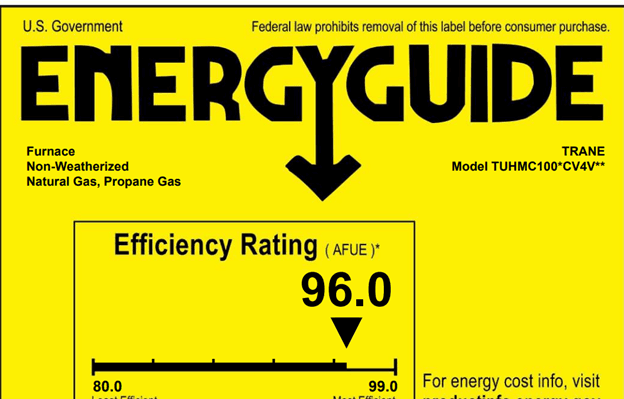What BTU and AFUE Should My New Furnace Have?
Summary: In this article, you’ll learn the answer to “what is a BTU”, that AFUE means annual fuel utilization efficiency, and hear from the experts on why you need to work with an HVAC professional to select the best furnace for your home.
By Anne Fonda
According to the U.S. Energy Information Administration (EIA), 52% of American homes heat with natural gas. Natural gas furnaces are most prevalent in the Midwest (70%), the West (60%), and the Northeast (57%).
Because a gas furnace can easily last 20 years, most homeowners only replace a furnace once or twice in their lifetimes. If now is the time to get a new furnace, make sure you know about BTUs and AFUE efficiency ratings.
Contact a Trane dealer for furnace guidance
What is BTU?
BTU stands for British Thermal Unit. One BTU equals the amount of heat required to raise or lower the temperature of one pound of water by one degree Fahrenheit.
How many BTUs does your current furnace have?
Your HVAC company can tell you how many BTUs your furnace has. But you can also do some sleuthing yourself. Look for a manufacturer’s sticker or plate on the side of your furnace. Google the model number and brand, and you should get the answer you’re looking for. The number of BTUs is included in a furnace model number for Trane furnaces.
For instance, in Trane furnace model numbers, the BTU is the middle number, such as 040, 060, 080, 100, or 120.
Those numbers translate to the following furnace sizes.
- 40,000 BTU furnace
- 60,000 BTU furnace
- 100,000 BTU furnace
- 120,000 BTU furnace
What BTU furnace do you need?
However, you may not need as many BTUs as your current furnace if you’ve done a bunch of home upgrades such as adding insulation, sealing windows and doors, etc. To get a ballpark estimate, you can use a furnace BTU calculator but be aware they are not nearly as accurate as the information you can get by working with an HVAC professional.
"Choosing a furnace with the correct BTUs ensures optimal heating efficiency, preventing both underperformance and excessive energy consumption. If the BTU output is too high, your system will short cycle, wasting energy and wearing out parts. Too low, and it won’t keep up on cold days.”
- Kimberly Sexton, Senior Systems Engineer

Work with an HVAC professional to get the right BTUs
Your best bet for ensuring that your new furnace has the right heating capacity for your home and climate is to work with an HVAC professional. They know how to size furnace BTUs so that you get a furnace that will keep you warm and potentially lower your heating bills. Their calculations will consider ceiling height, insulation, the condition of your ductwork, the number of windows and doors, and more.
What is AFUE?
AFUE stands for Annual Fuel Utilization Efficiency. It measures the percentage of fuel a gas furnace burns to heat your home, and the percentage remaining is what is vented out of your home as flue gas. For example, a furnace with an AFUE rating of 96 uses 96% of the fuel burned to create heat. 4% of the fuel is vented out as flue gas.
A high-efficiency furnace will have an AFUE rating of 90 or higher. The most efficient furnaces are condensing furnaces, which have a primary and secondary heat exchanger to help maximize fuel efficiency.
An AFUE of 80 is the lowest AFUE rating currently allowed by the Department of Energy (DOE).

You can find your furnace’s AFUE rating displayed on the Energy Guide sticker on your unit. If you can’t find the Energy Guide sticker, check your owner’s manual for the AFUE rating. You can also Google the model number to learn about the furnace.
Keep in mind that the older a furnace is, the lower its actual AFUE will be.
What is the AFUE rating of your current furnace?
Look for the yellow Energy Guide sticker on your furnace. If it’s still there and legible, it will give you the original AFUE rating. Older furnaces typically have an AFUE rating well below 80. If you have the owner’s manual for the furnace, that may also indicate the AFUE rating when the furnace was new. You can also Google the model number and brand to learn more about your current furnace.
The AFUE you need if you pair your furnace with an air conditioner
If your furnace is your only source of heat and your winters get pretty cold, you’ll benefit from a furnace with a higher AFUE rating. If your furnace runs all winter long, that higher AFUE rating can save you money on your energy bills.
The AFUE you need if you pair your furnace with a heat pump
“Combining a heat pump with a furnace creates a highly efficient and versatile heating system that leverages the strengths of both technologies. A heat pump excels in moderate climates, providing a comfortable environment in the home, and minimizing temperature swings. “
- Kimberly Sexton, Senior Systems Engineer
While a higher AFUE rating makes the furnace more efficient, if you’re getting most of your heat from a heat pump and the furnace will only kick in during freezing temperatures, and you live in a mild climate, you may find that an 80 AFUE furnace that’s compatible with your heat pump would work.
However, if you live in a colder climate, you may want a more efficient furnace to pair with your energy-efficient heat pump to get the best of both worlds.
“A furnace can deliver reliable and powerful heat when outdoor temperatures drop significantly. This combination provides the homeowner with consistent comfort while optimizing energy use and reducing utility bills. This hybrid approach not only enhances performance but also provides a robust and sustainable home heating solution,” Sexton said.
Work with an HVAC professional to get the right AFUE rating
An HVAC professional can help you run the numbers to show you how a higher efficiency furnace can help save you money on your heating bills for years to come. They can also help you weigh the pros and cons of other furnace factors, such as the number of heating stages.
“The right combination of BTUs and AFUE not only maximizes performance but also minimizes operational costs and environmental impact, embodying the essence of smart, sustainable engineering."
- Kimberly Sexton, Senior Systems Engineer
What does the number of heating stages have to do with efficiency?
In general, the more heating stages a gas furnace has, the more efficient it is at providing consistent heating throughout your home. For example, our 96 modulating variable-speed gas furnace provides greater fuel efficiency and precise temperature control to maintain your set temperature, while a single-stage furnace will start running at 100% capacity until it reaches the set temperature and then turn off. It will repeat that process when the inside temperature starts to drop.
But even a single-stage furnace can have a high AFUE rating. For example, our 96 Single Stage Furnace has an AFUE rating of 96. Work with your local Trane dealer to determine if a single-stage, two-stage, or variable-speed gas furnace is best for your home and heating needs.

How much does a new furnace cost?
The installed cost of a new gas furnace will vary based on the capacity, AFUE rating, and number of heating stages. Bigger capacity, better efficiency, and more heating stages all add to the price of a new furnace.
But remember, while a more efficient furnace will cost more upfront, it will reduce the amount of fuel the furnace burns, which can reduce your heating bills for years to come. In contrast, a furnace with a lower AFUE rating will cost less upfront, but may cost you more to operate in the long run.
To get a general idea of gas furnace prices, check out our Pricing Guide.
Work with your local Trane dealer for best results
When you need to replace your old furnace, reach out to your local Trane dealer to help ensure you get a furnace with the right heating capacity and efficiency. They’ll also work with you to make sure the furnace is compatible with your air conditioner or heat pump, and help you determine if you need to replace the whole system rather than just the furnace.
If your AC or heat pump is 15+ years old and requires repairs more often, it may be more cost-effective to opt for HVAC system replacement.
Anne Fonda, Content Writer
A Content Writer with Trane Technologies, Anne Fonda researches topics and writes for Trane® and associated residential HVAC brands. She works in collaboration with Trane Technologies subject matter experts, offering easy-to-understand, informative content on complex topics. Her goal is to help consumers make informed decisions on the products and services they need.
She has written for HVAC and other service provider websites for over 16 years. Before transitioning to web content writing, Anne had a 14-year stint as an award-winning journalist. She graduated cum laude from the University of Missouri-Columbia School of Journalism.
When she’s not working, Anne enjoys playing word games, reading, gardening, spending time with family, and visiting gardens and museums.
Expert review by Kimberly Sexton, Senior Systems Engineer
Related Articles




